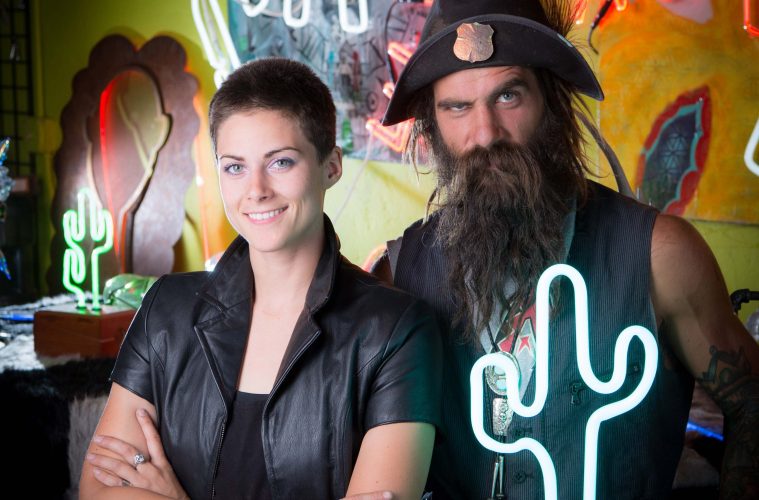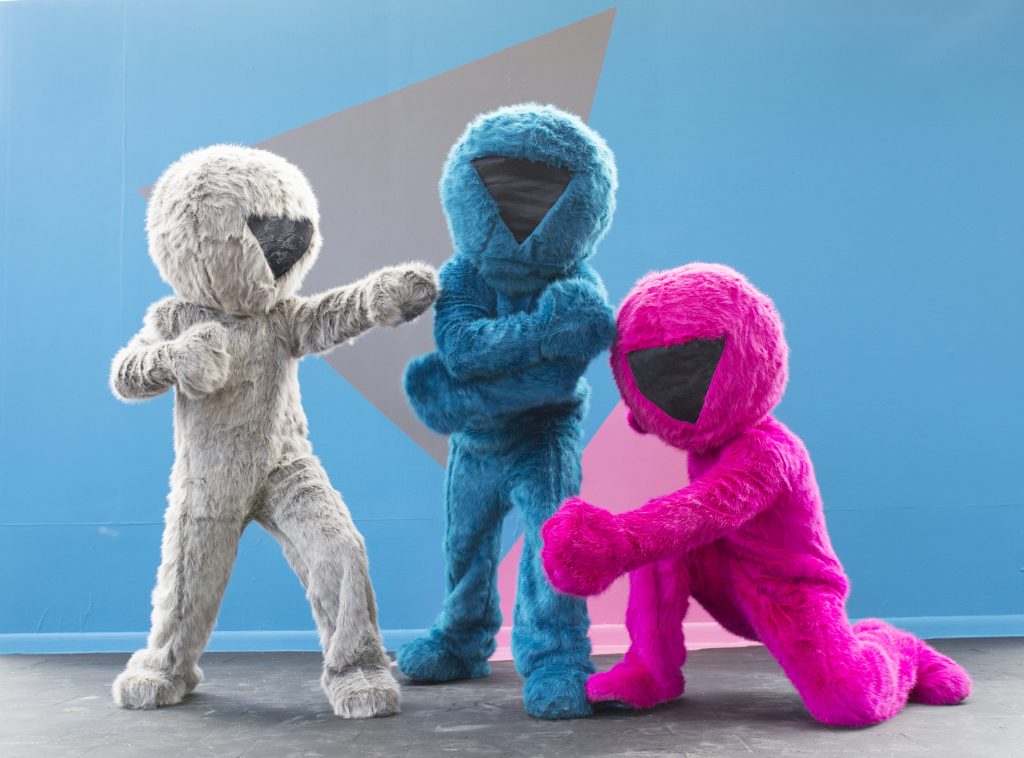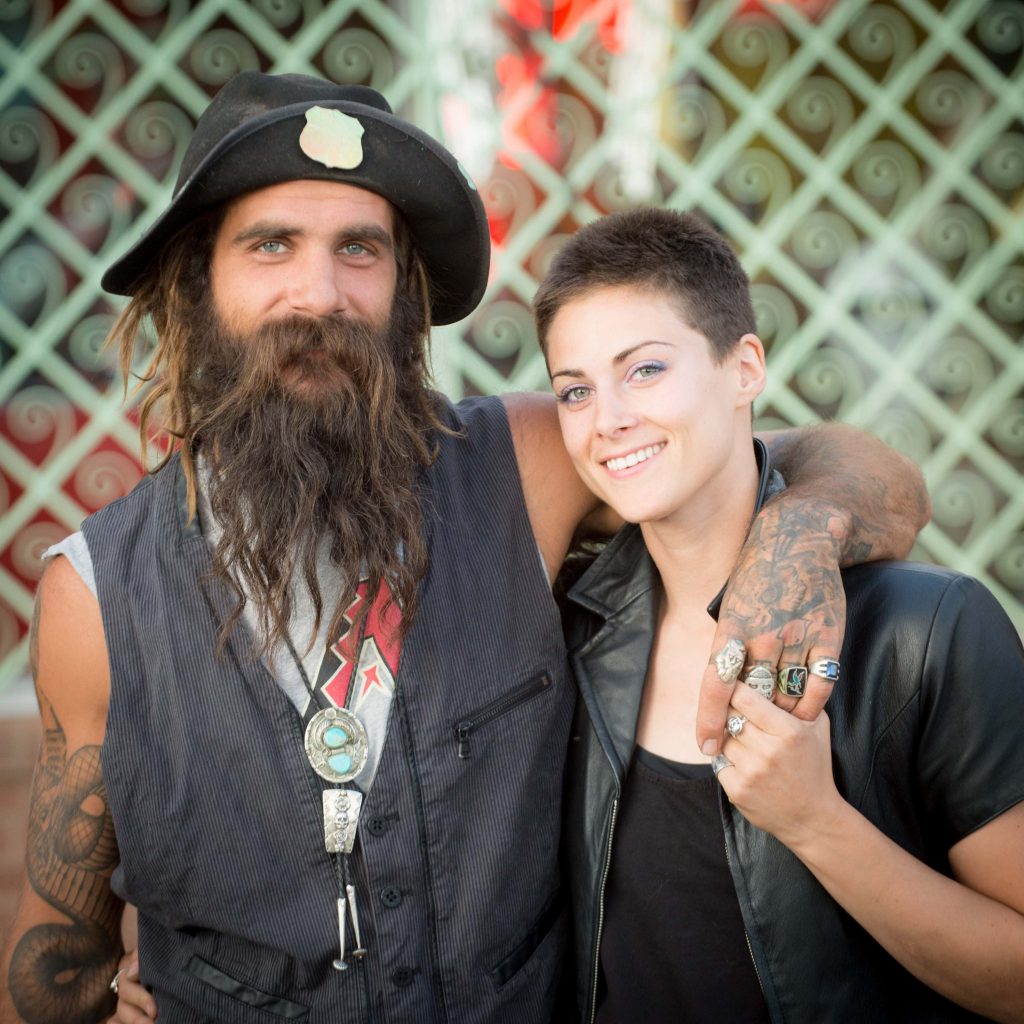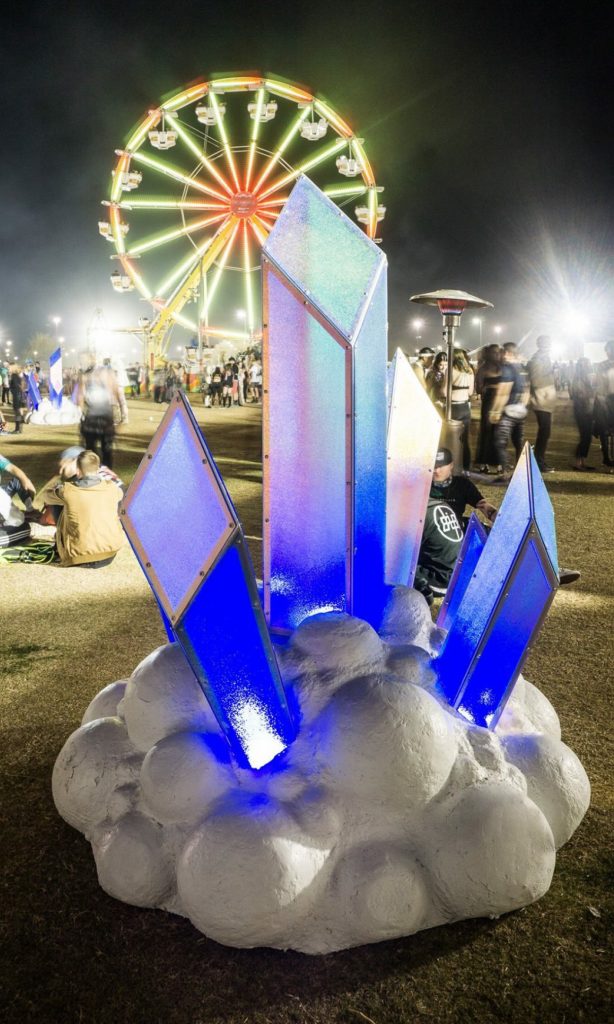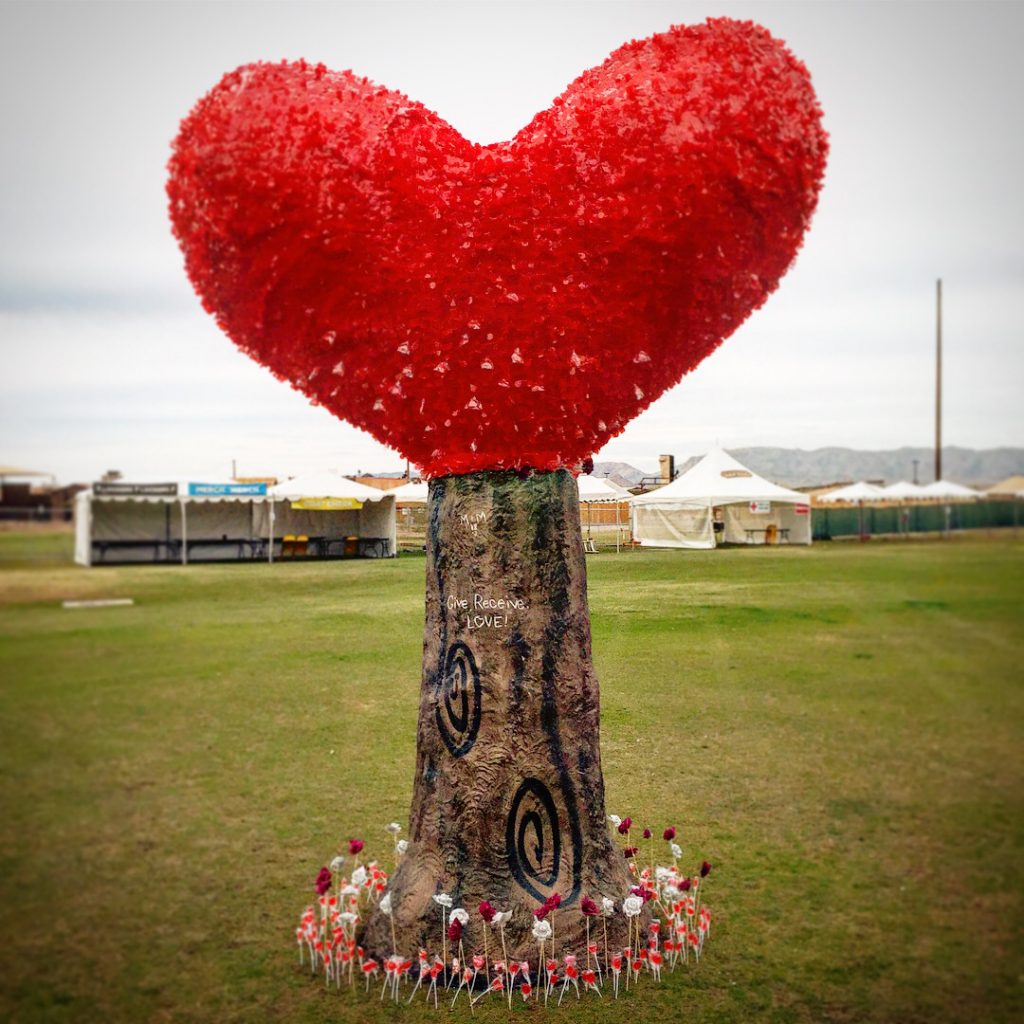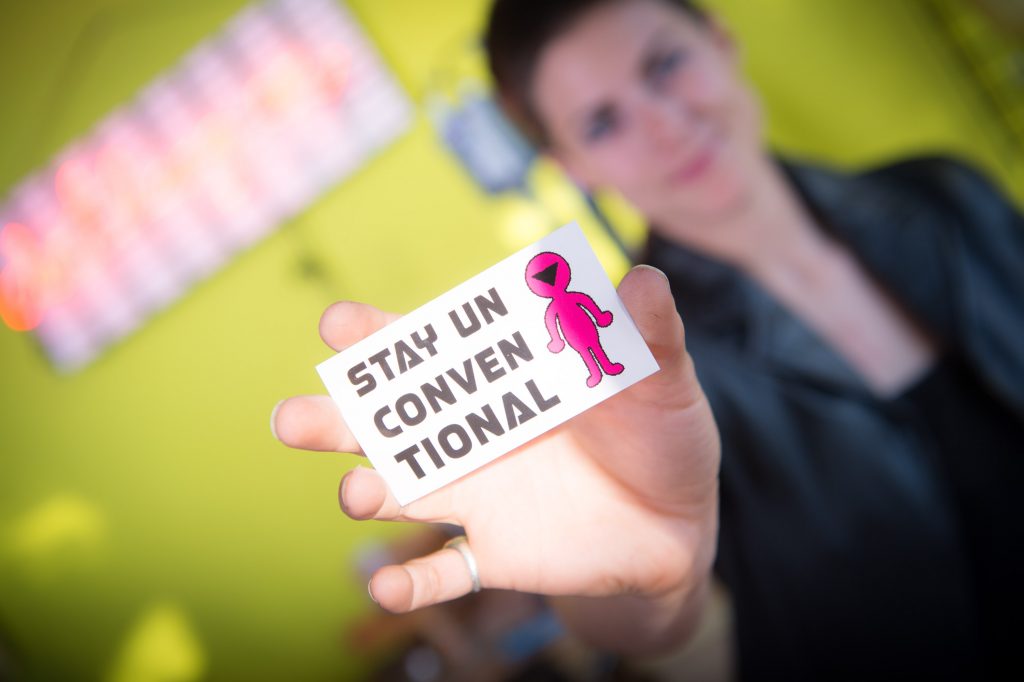It’s a clear spring evening at Steele Indian School Park, and the Pot of Gold Music Festival is in full swing. The arts and culture area of the festival is in a heightened state of activity. Artists are painting large sections of wood, vendors are selling an endless array of creative goods, and swarms of people are taking selfies in front of colorful art installations. While festivalgoers came here for Post Malone or Lil Wayne, those who ventured into the Art Village were rewarded with a feast for the senses.
The couple responsible for the stellar art experience is Mike Butzine and Michelle Meyer, better known as Snood City. The name Snood City represents everything that Butzine and Meyer do creatively together, whether it’s showing neon art at their space on Grand Avenue or creating immersive art installations for music festivals around the Valley.
The genesis of Snood City began on the dance floor during the New Year’s Eve Block Party at the Crescent Ballroom. Butzine joined in on a dance circle that included Meyer, and they caught each other’s eye. This would be a fortuitous, albeit brief meeting. It wasn’t until a year later, on a trip to Burning Man, that they would connect again – and this time for good.
Michelle Meyer, or “Meesh,” was born and raised in the Northwest suburbs of Chicago. She had family in the Phoenix metro area, so she ended up coming to ASU with the intent to study graphic design. Meyer explored other forms of art and found her passion in sculpture. She was especially attracted to one of the few remaining neon art programs in the country at ASU. She found camaraderie within the sculpture program, and a tight-knit community of artists developed.
When graduation came around, the students were encouraged by their professors to stick together and find a space of their own to make art. They founded Studio Seven, and Meyer thrived in this communal setting. The budding artist supported herself working at 11th Monk3y Industries on Grand Avenue, doing everything from managing the storefront to creating design. She was able to hone her craft and learn the business side of art making.
Mike Butzine, or “Mikey B,” grew up in North Phoenix and is a fourth-generation Phoenician. He played sports and was a promising athlete in high school, but an injury cut his sports career short. In the meantime, he started hanging out with a skateboard crew and got into graffiti. He traveled to the University of Hawaii to study oceanography. Butzine was attracted to island life at first but soon realized that he was a tried-and-true “desert rat.”
While at school he discovered his love for glassblowing. The art form led him to different locales, such as New Jersey, Oregon, and Virginia, in pursuit of perfecting his craft. Butzine eventually returned to Phoenix and immersed himself in the local glass-blowing scene at Circle 6 Studios and the Mesa Arts Center. Soon enough, he got involved at Unexpected Gallery and began coordinating events and curating art.
Butzine and Meyer had mutual “burner” friends who made the trek to Burning Man every year. Meyer had gone the year prior, and it was Butzine’s first time. They were in the same camp that travelled from Phoenix to Black Rock City, and the pair hit it off right away. “I was just dancing,” Meyer recalls. “I turn around and Mikey B was there. I was like, word. All right, we’re crewmates for the night. Because once you split from the rest of the group, there’s no point in trying to find them. So we just ended up running around the playa and talking about all the crazy things.”
“It was my first time at Burning Man,” Butzine said. “Having gone to school for fine art, you learn about the white-walled gallery. Going out to Burning Man totally changed the idea of what the gallery was to me. Now we’re not limited to this building. Now you can make anything. You can make it huge, magnificent, and an all-enticing kind of experience. For me, it was such a new place. I was exploring new ideas, and Meesh was there, and we got to bounce around ideas. There were just things we’ve never even seen or heard before.”
The experience from Burning Man would have a lasting effect on the couple; however, Snood City didn’t happen overnight. Butzine and Meyer had ideas percolating long before Burning Man, and this experience would just catalyze them to take their creative endeavors to the next level. The idea of Snood City began with Meyer when she was taking sculpture classes at ASU. She was given a prompt in class to create a piece that had a twelve-foot footprint in all directions.
Her roommate’s boyfriend at the time worked at a place that had access to a large amount of unusable furry bits of fabric in all sorts of colors. He called them “snoods.” Meyer came up with the idea to cover a large room in this fur material. She covered the floors, the walls, and the furniture. She then created a character “that grew out of the room, to walk around the gallery, to interact with the attendees, and named him Snoodmen,” she said. “He was part of and came from the snoods, and it was that idea of how art isn’t just about this thing that you look at on a wall. It’s about experience and exchange and that interactivity.”
After this art epiphany, Meyer was obsessed with Snoodmen and expanding its visibility. She created an LLC to protect her intellectual property, which came in handy as her creative activities multiplied. “I had set up the LLC back in 2015,” she said. “I had everything ready to go. I had the bank account and everything in line. Part of the reason I set up Snoodmen is about this artistic exchange and involving people. It fits what we want to do. This freedom of expression, staying unconventional, they went hand in hand, so we decided to roll with it. So we started doing everything under Snoodmen, and the extension of that is Snood City.”
Meyer started incorporating Snoodmen into everything from t-shirts to a music video. Snood City became active with smaller events like AncientFuture, which presented a festival atmosphere in intimate venues. They were given an opportunity to create a kind of lounge area, and Meyer put the Snoodmen treatment on it. “We got a taste for event installation art, and it was just like, ‘Yeah, we want to do more of this,’ so we kept working,” Meyer said. “They never really had a budget, but it was the ability to be able to curate our portfolio and be like, ‘Hey, we’ve done this.’ We knew we wanted to do more stuff like that, so it was good to have a place to actually make it where people could see it.”
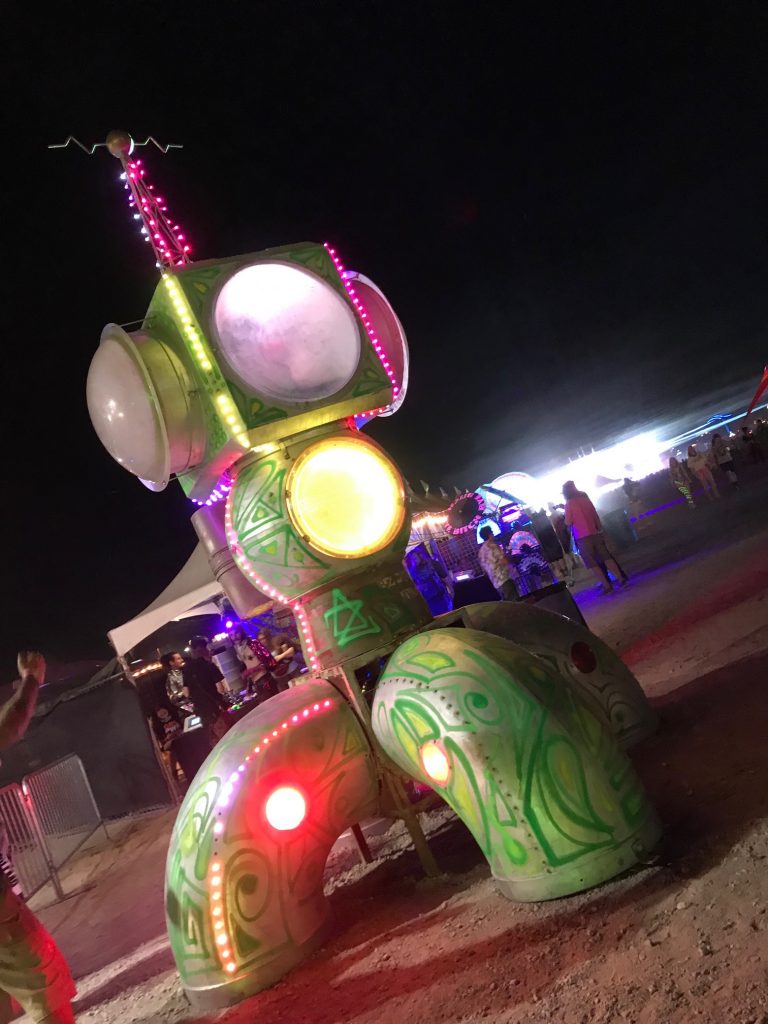 From the stellar work they did at these smaller events, they proved themselves to the right people and ultimately connected with local EDM production company Relentless Beats. In one project after another, Snood City impressed with their hard work and inspired creativity. They would go on to create work for popular music festivals such as Goldrush, Decadence, and Phoenix Lights.
From the stellar work they did at these smaller events, they proved themselves to the right people and ultimately connected with local EDM production company Relentless Beats. In one project after another, Snood City impressed with their hard work and inspired creativity. They would go on to create work for popular music festivals such as Goldrush, Decadence, and Phoenix Lights.
Butzine and Meyer are quick to point out they can’t do it all alone. They have a circle of friends and artists who help them create, build, and install work. These kindred spirits are able to apply their talents and learn new skills. A few gravitate back for multiple projects, while some move on to other things. Snood City is always open to collaborating with other talented creatives, as well. “We love to see other people who are doing it and are on that level but maybe in a different arena,” Meyer said. “Seafoam Collective with hip-hop, Weezy’s Playhouse with fashion, those are the people we want to collaborate with. Snood City is all encompassing.”
Snood City’s newfound success enabled Butzine and Meyer to obtain suitable studio space and a workshop. They looked at several spaces but knew it had to be on Grand Avenue. They were offered affordable space to rent, without really knowing exactly what they were going to do with it. That would eventually become Snood City Neon, a storefront on Grand Avenue that functions as a retail space and gallery, with an event space in a back outdoor area that hosts an open house every First Friday.
“This whole installation thing is fun, but it is more than that because it was something us two could do together. We both went to school to do our own things, to become our own artists,” Butzine said. “But together, we’re able to do more. I have a different set of tools than she has. We’re really able to complement each other. Then there is the whole love, life, business, and art intertwining. We’re still figuring it all out.”

